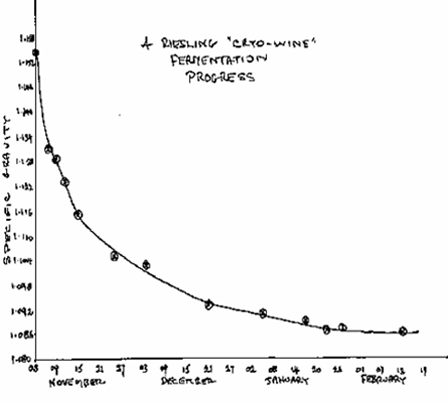VAWA
The home of amateur winemaking in Vancouver
Cryo Concentrated Dessert Wine
2002
A very satisfactory dessert "icewine" can be made without having to undertake the rigours of leaving the grapes on the vines (for the birds) until it hits minus 7ºC or whatever, then picking them in the middle of a frozen night. Even if you live in a part of the world where such rituals are performed, which you probably don't, there is another way.
Your deep freeze can do the job for you.
Start with pressed white grape juice that has the TA, pH and sugar levels much as you would normally use for table wine. The pH should be below 3.5. If the sugar content is a bit higher than table wine levels, so much the better.
Any white grape should work, but Gewürztraminer, Riesling or Muscat Canelli have particularly good fruity characteristics for this type of wine.
Use one of those "five gallon" white plastic pails that you are prepared to sacrifice - your juice may have even come in one. Fill it with juice, sulphited at around 10 to 15 mg/L SO2 if you wish, and put it in the deep freeze for about a week. The juice turns to sludge after a day, but ice crystals slowly continue to form over a longer period of time.
Start the thawing and draining process first thing in the morning of a day when you're going to be home. It will take most of the day and you need to keep an eye on it.
Get a second empty five-gallon pail or other suitable container. Rest two clean boards, with a gap between them, on top of it to support the bucket of frozen stuff.
Place the bucket of frozen juice on the boards, then go and get your electric drill and a friend to help. You need to drill several holes through the bottom of the bucket to turn it into a strainer. Six millimetre holes are about right, but difficult to drill right off, as the bit will skid all over the place. Get your friend to tilt the bucket so you can get at the bottom. Drill small pilot holes so they will be over the gap between the boards. Don't worry about the bits of plastic from the holes. Be ready for syrup to start coming out. Now enlarge the holes with the bigger bit.
The syrup will be quite thick at first, getting more watery over several hours, as some of the ice begins to melt.
You are aiming for a starting gravity of somewhere around 1.150 - 1.160 - even more if you wish. When the concentrated juice in the bottom bucket is at the specific gravity you want, stop draining and get rid of the top bucket and the ice left in it. You can probably ignore the effect of the cold temperature on the hydrometer reading. It's not going to be significant.
You are going to wind up with roughly half the volume you started with. It doubles the cost per bottle but I think you'll feel it's worth it. After all, look at what a half bottle of commercially made icewine would set you back.
You have now concentrated acid as well as sugar and flavour. The pH should be safely below 3.5 and the acid in the neighbourhood of 10 - 11g/L. This style of wine requires high acid levels to balance the effect of the sugar.
Fermentation should be conducted in a cool place using a yeast with low alcohol tolerance and a reputation for preserving the fruity aspects of the grape. I have used Epernay Two and Lalvin 71B-1122 with success.
A total specific gravity drop of 75 to 80 points will provide plenty of alcohol. 10 - 11% is fine.
Below are some details of a Riesling "cryo-wine". After freeze concentrating, the SG of the must was 1.154 and the TA 9.4 g/L. The wine fermented slowly in a cool part of the basement. I find it useful in this sort of situation to record the progress of the specific gravity on a graph with the date on the horizontal axis and SG on the vertical. On January 8 I noted "tastes great - allow to drop to 1.080." The wine was racked on January 27 with only 10 mg/L SO2 , as I wanted it to ferment a bit more. It wouldn't so I wound up with a finished product of SG 1.086, which turned out just fine.

If the ferment hadn't stopped so readily, I would have chilled the wine right down, let it settle for a few days and racked it again this time using 30 - 50 mg/L SO2 . I might have even filtered it using a medium filter - a somewhat tedious job with a high residual sugar wine. Note that it is the chilling and racking to remove live yeast cells that slow or stop the fermentation, not the SO2 , which will merely irritate the yeast but won't kill it.
A Gewürztraminer that didn't stop so readily had a starting SG of 1.156. It got chilled, settled, racked, sulphited and filtered. At bottling, the SG was 1.079, TA 10.6 g/L, pH 3.45, free SO2 40 mg/L, total SO2 175 mg/L and potassium sorbate 250 mg/L.
A year after bottling it was quite delicious.